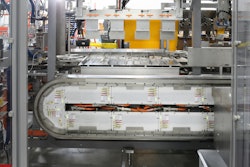Giacomo Girotto, Vision Inspection Project Manager at Stevanato Group, presented “Unlocking the potential of Artificial Intelligence to enhance visual inspection performance” at today’s PACK EXPO Connects Innovation Stage. In particular, Girotto addressed how deep learning can bring advantages to the pharma market.
The biggest benefit, Girotto said, is the increase in inspection performance and a consequent increased detection rate, which also brings a reduction of the false projection rate.
A higher detection rate will put products with fewer defects on the market, while reducing the false rejection rate will reduce waste during production.
Benefits of deep learning applied to visual inspection:
· Increase Detection Rate while reducing false reject rates
· Minimize setup and parametrization timings
· Avoid costly re-inspection of gray items
· Shift to a predictive model to monitor process flow
Girotto said deep learning could be used for applications such as Lyo cake inspection, suspension inspection, air bubbles vs particles, and determining cosmetic defects.
What is Deep Learning in Vision Inspection?
Traditional algorithms (machine learning), need to be developed by SW vision engineers and tuned by quality operators to work properly. The programmer decides which features of the product are relevant for the inspection (area, length, color, etc.) and the operator sets the accept/reject criteria.
Neural networks (deep learning), on the other hand, learn by example: Given several labelled samples, the network autonomously learns which features are relevant and the accept/reject criteria.
A neural network is composed by several layers of artificial neurons. Each neuron can be activated or deactivated by the input, and, putting together all the neurons of each single layer, the network can recognize features and shapes (simple features in the first layers, complex ones in the deeper ones).
For the detailed findings from Stevanato’s research on deep learning in the pharma market, click here to see the full presentation, available through March 31, 2021. To see more PACK EXPO Connects, click here.


























